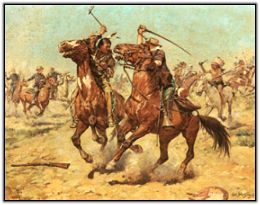| Miles moved more troops to contain the cult
(Ghost Dance). But, to his surprise, there was little or no violence after
Sitting Bull's death. ... The largest band of presumed hostiles was that
of old Big Foot, Minneconjous and 40 or so Hunkpapas. Miles ordered Colonel
Edmund V. Sumner to round up the chief, but the veteran officer stalled.
He argued that an arrest was unnecessary and counter-productive, probably
inciting a fight. Big Foot, frightened by the Army's warlike preparations, fled with his people toward the Pine Ridge Agency. ... He (Miles) sent several units to intercept him and prevent him rendezvousing with the Brulés und Oglalas. One of these forces was the 7th Cavalry, Custer's old outfit. Big Foot consented to being escorted to Pine Ridge by the military. But Colonel James W. Forsyth ... had orders from Miles both to disarm Big Foot's people and to march them to the railroad for shipment to Omaha. All this was, of course, against Sumner's advice. When the Sioux encampment awakened on the morning of 29 December 1890, its people found that Forsyth had surrounded them with 500 troops and had posted four rapid-firing Hotchkiss cannon to cover them. |
 "The Duell - Tomahawk and Sabre" by Carles Schreyvogel |
|
As the squaws began to break camp and
pack up to move, Forsyth lined up the 120 men and orderd them to turn
in their weapons. When only few token guns, mostly broken, were surrendered,
he searched the lodges and found arms and ammunition hidden in them. Next,
he ordered a body search of the Sioux, men and women, for weapons concealed
under their blankets. The Sioux were angered by this humiliating procedure,
of corse ... A single soldier and a warrior got into a scuffle. Someone,
probably this enlisted man, fired a shot, perhaps accidentally ... Forsyth
troops opened fire on the crowded camp at close range. The soldiers were
excited, scared, perhaps vengeful, remembering Little Bighorn. Their small
arms fire was deadly at such close quarters, but it paled before the bloody
work of the Hotchkiss guns.
To the Indians and many sympathic whites, the Battle of Wounded Knee was not a battle at all, but a massacre. That it was, but only in part. It was not a massacre in the sense of the deliberate slaughter of Sand Creek in 1864. For it was also a battle or, at least, a real skirmish. Forsyth lost 25 officers and men killed, and had 39 wounded. Big Foot and his medicine man, Yellow Bird, were among the 150 Sioux dead on the frozen ground. There were another 50 Indians wounded. Probably the large number of women and children, 62, among the Sioux casualties was the result of wild firing by riflemen and Hotchkiss gunners at close quarters. In fact, some of the Army's own dead and wounded were the accidental result of gunshot and shrapnel wounds from friendly fire. The public was horrified by Wounded Knee and compared it to Sand Creek. Miles saw it as a stupendous blunder by Forsyth. He relieved him of his command and summoned a court of inquiry. ... But Miles had erred, too, in ordering Forsyth to disarm the Sioux and entrain them to Omaha. As Sumner said, Big Foot could have been escorted peacefully, to Pine Ridge had the Colonel not tried to seize all Indian weapons.(9) |
|